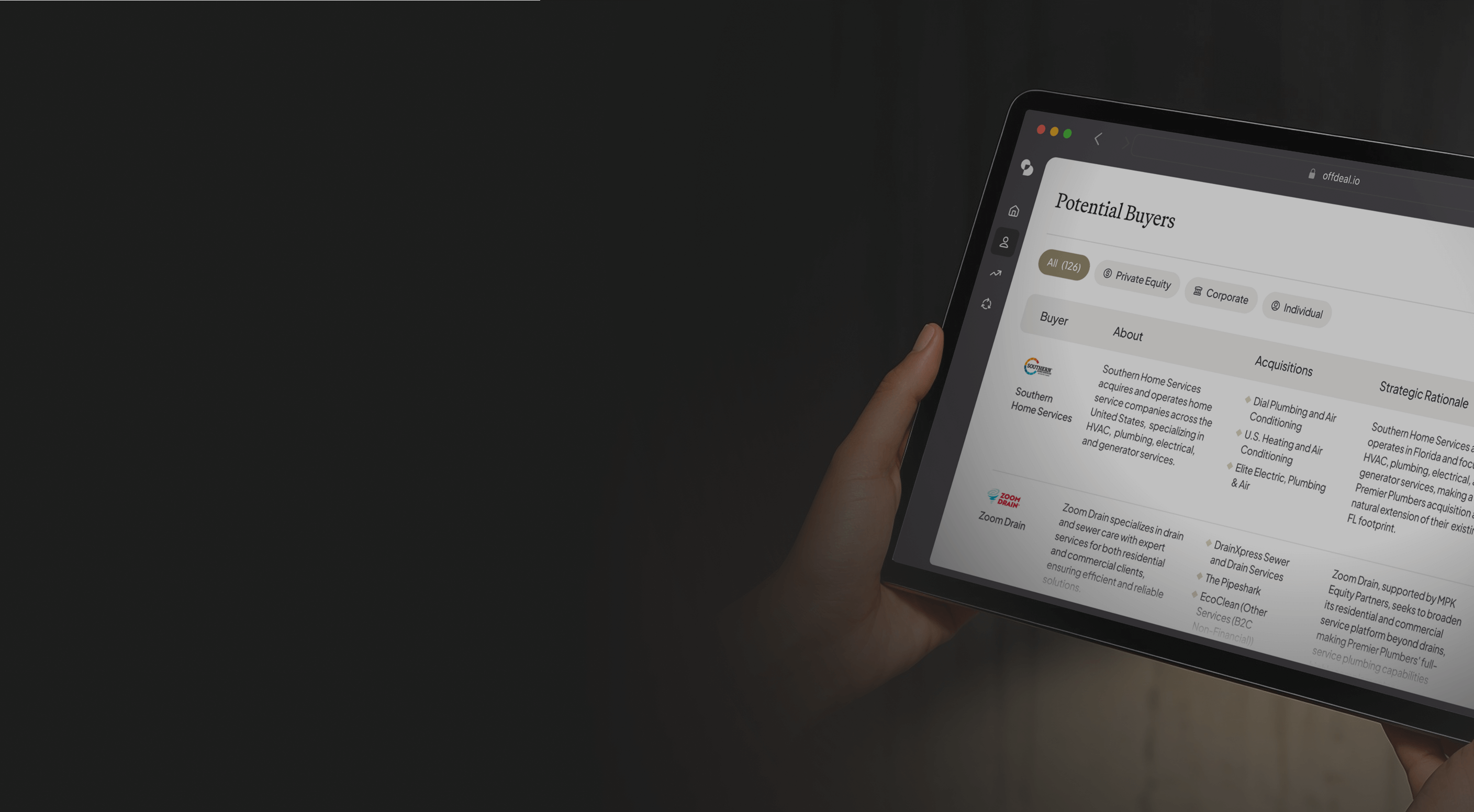Article
March 2, 2025
How to Maximize Valuation for an Automotive Repair Business
Selling Your Automotive Repair Business? Learn exactly how to boost valuation, attract serious buyers, and secure top-dollar

Table of Contents
Selling your automotive repair business might seem straightforward, but capturing maximum value from your life's work involves more than just clean financial statements and solid profits. Whether you're an independent automotive service center, specialized transmission repair shop, or a franchise location, buyers carefully weigh factors like long-term profitability, recurring income, customer concentration, and operational systems when determining what they're willing to pay.
As an automotive repair shop owner, you've probably dedicated years to building loyal customers, training a qualified team of technicians, and optimizing your services. The question now is how to translate these years of hard work into the best possible valuation and sale price.
In this guide, we'll examine why automotive repair businesses command different valuations and how you can strategically improve your auto repair shop's worth to potential buyers. Specifically, we'll cover:
The critical role of your service mix and revenue streams
Why recurring business means higher valuations
How customer diversity impacts buyer risk assessments—and valuation multiples
Managing operational risks, including staff expertise and owner dependence
Practical steps to prepare your business for maximum valuation before selling
Let's dive deeper into what potential buyers value most in an automotive repair business and how to leverage that insight to your advantage.
Why Automotive Repair Businesses Command Varying Valuations
An automotive repair shop is generally considered a "needs-driven" service—a reliably stable business in good and bad economic times. Vehicles break down, brakes wear out, and tires need replacing, regardless of market downturns. While this inherent resilience makes the industry attractive, not every automotive repair business garners the same favorable market valuation.
Here's why valuations can vary significantly between similar automotive repair businesses:
Service Type & Recurring Revenue: Shops providing a consistent stream of revenue—like fleet maintenance, scheduled servicing, or regular inspections—earn higher valuation multiples compared to purely one-time emergency repairs.
Customer Base Diversification: Broadly diversified revenue from various customer segments (commercial fleets, individuals, dealerships) reduces risk versus heavy reliance on one or two large accounts.
Operational Efficiency and Documentation: Automotive businesses with clearly defined standard operating procedures, well-trained personnel, and less reliance on the owner typically command stronger valuations.
As a business owner, you want to identify these essential attributes clearly, demonstrate their strength, and prove to potential buyers that your automotive repair company is stable, predictable, and primed for continued success.
The Impact of Recurring Revenue vs. One-Time Jobs
Buyers place a premium on predictable, recurring revenue. For automotive repair businesses, this generally comes from regular maintenance services, fleet contracts, and scheduled customer services.
Recurring Revenue (Preventive Maintenance & Fleet Services):
Advantages:
Consistent, predictable revenue streams.
Stronger customer relationships through regular contact.
Less cyclical, lower risk profile.
Valuation Impact: Typically commands higher valuation multiples (4–6x SDE).
Non-Recurring Revenue (One-Off Repairs & Emergency Work):
Advantages:
Higher profit per individual job.
Opportunity to upsell additional services.
Disadvantages:
Revenue volatility; inconsistent sales cycles.
More difficulty forecasting future earnings.
Valuation Impact: Typically lower multiples (2–4x SDE).
| Revenue Model | Stability | Valuation Multiple Range |
|---|---|---|
| 75–100% maintenance contracts | Very high | 4–6x (higher) |
| Balanced (maintenance & emergency) | Moderate | 3–4x (moderate) |
| Primarily emergency, non-contract | Lower | 2–3x (lower) |
Multiples of Seller’s Discretionary Earnings (SDE)
Why Customer Diversification Reduces Risk & Increases Value
When buyers evaluate automotive businesses, customer concentration becomes a critical factor in their risk assessment. Companies overly reliant on a handful of customers or a single fleet management contract create concern that losses could lead directly to financial downturns.
Highly Concentrated Customer Base Risks:
Revenue vulnerability if losing one or two major accounts
Buyers' lower confidence, translating into lower valuation
Diversified Customer Base Benefits:
Spreads risk across many clients and service types (fleets, individuals, dealers, insurance repair contracts)
Higher perceived stability boosting valuation multiples
Example Scenario:
| Factor | Repair Shop A | Repair Shop B |
|---|---|---|
| Annual Revenue | $2.0M | $2.0M |
| Seller’s Earnings (SDE) | $400,000 | $400,000 |
| Top Customer Concentration | One fleet customer = 60% of revenue | Top customer around 5% of revenue |
| Customer Segment | Limited fleet segment | Mix of private vehicle owners, fleets & dealers |
| Valuation Multiple | 2.5x | 4.0x |
| Estimated Total Valuation | $1,000,000 | $1,600,000 |
Clearly, minimizing customer concentration boosts value significantly.
Operational Strength: Owner Dependence, Training, & Documented Processes
Buyers closely consider operational effectiveness when acquiring automotive repair businesses. High reliance on the owner raises concerns that transitioning ownership will impact business continuity and revenues.
Over-Reliance on Owner:
Reduces buyer confidence and valuation.
Creates uncertainties around skill transfer and customer retention.
Well-Trained Employees & Operational Documentation:
Boosts buyer confidence in operational continuity.
Maximizes valuation through documented standard operating procedures, roles, shop manuals, training programs, and standardized processes.
Practical Steps to Maximize Your Automotive Repair Business's Valuation
Fortunately, there are concrete steps you can take before listing your business that dramatically improve your valuation:
Build & Expand Recurring Revenue:
Secure fleet maintenance contracts, prepaid annual service plans, or scheduled maintenance packages.
Create reminders for vehicle inspections, oil changes, brake check-ups, and tire rotations to stimulate repeat visits.
Diversify Your Customer Base:
Actively pursue multiple customer segments: fleets, dealerships, insurance carriers, private car owners.
Never depend on a single large client or revenue stream for more than 10–15% of your annual revenue.
Reduce Owner Dependence & Implement Strong SOPs:
Write down standard operating procedures (SOPs) clearly outlining operations, scheduling, customer service policies, and quality-control processes.
Train staff thoroughly; seek industry certifications (such as ASE) ensuring high-quality standards independent of owner oversight.
Demonstrate Clear Growth Potential:
Develop credible growth plans (new services like electric/hybrid car maintenance, geographical expansion, digital marketing initiatives).
Showcase historical marketing ROI and future projected growth opportunities.
Organize Financial Statements & Keep Them “Clean”:
Eliminate personal expenses from your company's profit and loss statements.
Maintain orderly, transparent financial documentation to inspire investor trust and confidence.
Real-World Automotive Repair Business Valuation Scenario
Here is a direct comparison of two automotive repair companies to illustrate how factors like recurring revenue, customer diversification, SOP implementation, and reduced owner dependence significantly impact valuation:
| Characteristic | Auto Repair Business A | Auto Repair Business B |
|---|---|---|
| Revenue | $1.5 million | $1.5 million |
| Earnings (SDE) | $350,000 | $350,000 |
| Revenue Breakdown | 85% scheduled maintenance contracts, 15% one-off repairs | 90% emergency fixes/one-time jobs, minimal scheduled work |
| Customer Base | Diverse – fleet customers, dealerships, individuals; no single customer >10% revenue | Not diversified – Two fleet customers account for most revenue |
| Owner Role | Minimal daily operational oversight; SOPs in place | Owner heavily involved in daily operations; no documented SOPs |
| Valuation Multiple | 4.5x | 2.5x |
| Estimated Total Value | $1,575,000 | $875,000 |
Business A commands a substantially higher valuation due to predictable revenue, diverse customer base, documented operations, and minimal owner dependence.
Next Steps: How to Start Preparing for Your Business Exit Today
When aiming for top dollar when selling your automotive repair business, it's critical to begin preparations early. Maintain clean financial records, nurture diverse revenue streams, implement robust operational systems, and demonstrate steady growth to maximize buyer confidence and subsequent valuation.
Remember, thoughtful preparation makes all the difference. Taking measured, strategic action now means fewer headaches, less risk perceived by buyers, and ultimately, achieving the maximum valuation from your automotive repair company's sale.
Schedule a Free Confidential Consultation Today to:
Evaluate your automotive repair shop's current valuation.
Understand specific automotive market trends and buyer preferences.
Identify personalized opportunities immediately to improve your business valuation before selling.
Gain clear next steps for the selling process—designed around your unique exit objectives.
You spent years building your automotive repair business. Now let's ensure you earn maximum value when it's time to sell.

Preview Buyers for Free
Try our buyer match tool to receive a personalized list of active buyers in your industry

